Daily maintenance - a key function often ignored
In this article, we look at the pre-start checks for mowing machinery and the correct end-of-day maintenance that should be carried out on each machine. It is, of course, all covered in your operator's instruction book, with details of each check, location of all service points and much, much more. If only more people took the time to read them!

Pre-start Checks
As the title suggests, these checks should be carried out before the machine is used or, in some cases, at the start of each shift. This way, the operator has checked that the function of the machine is correct, and the safety systems are in place and fully functioning.
Visual Inspection: A quick visual inspection or walk around the machine should identify any external damage, and/or any missing parts. Any oil or fluid leaks should be immediately apparent and can be dealt with before the machine is started or moved. Once complete, a more detailed inspection can take place.
Tyres: The correct tyre pressure for the machine should be known by the operator. However, it is surprising that many operators have no idea what they are. Tyre pressures are critical to machine performance and comfort, so it is important to check them.
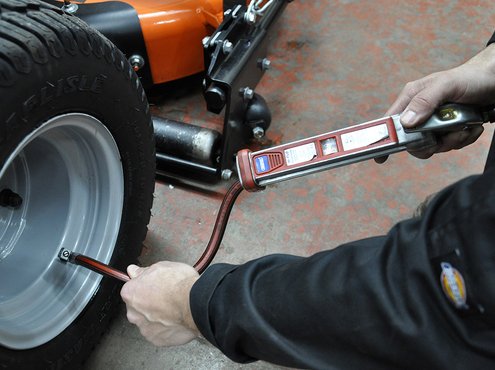

The condition of the tyres should also be checked. Any cuts, bulges or other damage to the tyre walls and tread areas should be carefully inspected and reported as faulty.
Wheels: Wheel rims can take a real pounding when machines are driven up curbs all day. The wheels should get a regular visual check for cracks and other damage. Wheel nuts and studs do tend to come loose, so these need a daily check.
Hydraulic Hoses: As you walk around the machine checking the wheels and tyres, be sure to check all hydraulic hoses for wear, ageing and fatigue.
Any signs of rubbing or chafing need to be reported and dealt with before the outer rubber protection is damaged or worn away. Hydraulic oil leaking under pressure is a serious health hazard; if you have any signs of leakage, report it and don't use the machinery until the leak has been investigated and fixed by a competent mechanic.
Radiator and Cooling System: The radiator on a ride-on mower works more intensely than almost any other cooling system. The radiator screens can get blocked with grass clippings and pollen and, in certain conditions, will need continual attention to prevent overheating. Check that all the screens are clean, and correctly fitted to the machine.
Check the coolant level using the expansion tank marks (on a fully pressurised system) or, on an overflow system, remove the radiator cap and check the water level. Always use a 50/50 coolant mix and check the operator's manual for further details.
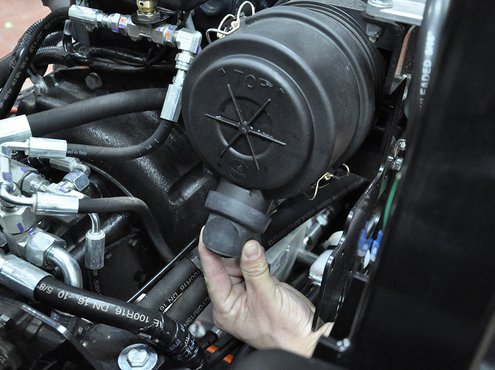
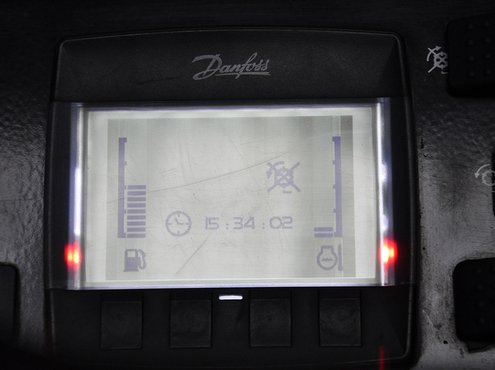
Air Filter: The air filter intakes its air from the same airbox as the radiator. If the radiator needs cleaning, so will the air filter. It may not be necessary to remove the filter body, but the end cap needs to be removed and inspected for dust and debris. Any build up here may mean removing the air filter body and tapping it gently to remove the dust and debris. Always check that the rubber boot on the end cap is in place and in good condition. If it is damaged, it should be replaced so that the air flows correctly through the filter.
Engine Oil: It's the most obvious daily check to make, and should always be done before the engine is started. A regular operator should know whether his machine uses any oil or not, but anyone using a different machine must check the engine oil before starting the machine.
Hydraulic Oil: The hydraulic oil level can be checked by using either a sight glass or a dip stick. When topping up the system, be sure to also check the viscosity of the oil so that you ensure that the correct grade of oil is added to the system!
Hydraulic System Filters: Some of the oil filters will have a tell-tale gauge or warning light fitted to alert the operator of a blockage or build-up within the filter. For these to operator correctly, the oil must be at working temperature. Cold oil will be too thick to flow through the filter correctly and the warning lights may need to be ignored until the system has heated up.
If any warning lights stay on, immediately stop the engine and consult the operator handbook. That will detail how to correctly interpret the information.
ROPS Frames: The securing pins or bolts need to be correctly in place. Any missing or damaged parts need to be replaced, otherwise the security of the ROPS will be affected.
Up or down? If the ROPS frame has been lowered, then there should be a clearly understood reason for it. By default, the ROPS should be raised, and only lowered when an overhead obstruction creates a greater risk. Refer to your risk assessments for guidance on when, where and under what circumstances the ROPS can, and should, be lowered.

Operator Presence Controls (OPC's): The built-in safety systems on every modern machine are there to protect the operator. They must be tested at the start of every shift and any faults should be checked by an experienced mechanic.
On some machines, there is a flashing light sequence on the
dashboard:
1 flash = seat, 2 flashes = parking brake,
3 flashes = cutter drive engaged.
A simple function test should check the purpose of these in under a minute.
In addition, many machines will disconnect the cutter drive if the operator leaves the seat. Again, a simple safety circuit to test; run the cutting system and stand up. Either the cutters should stop, or the engine should stop.
No one should be operating a piece of machinery without testing the safety circuits which are there to protect them.
Cutting Decks and Cutting Units.
Rotary decks are often overlooked, but a daily inspection should be carried out to cover the following key areas:
Rollers: All decks will have anti scalping skids and/or rollers. These should be checked for wear and damage, as well as correct adjustment. Any damaged or missing parts need to be reported so replacement parts can be ordered.
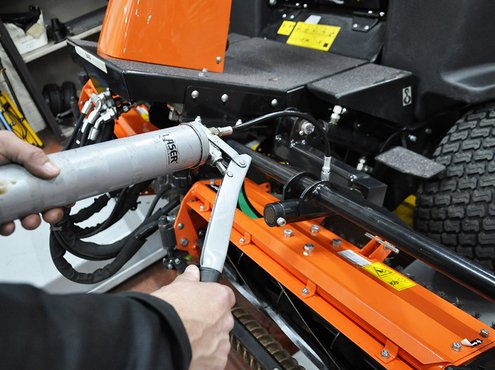

Rotary Blades: The blades and the cutting edge should be checked for damage. Once worn, they should be removed, and another set fitted. Worn or dull blades can be sharpened, balanced and re-fitted. Leaving the blades on too long results in an inferior quality of cut, higher fuel consumption and a blade which cannot be sharpened and returned to work.
So, failing to check and sharpen the blades costs time, fuel and profits!
Height-of-Cut: All rotary decks have adjustments at the front and the rear of the deck. Too often, decks are adjusted by moving the front wheels only, resulting in decks which are set at the wrong angle. The performance of the machine can be severely affected by incorrect deck adjustments, so check the decals of the deck for the correct pin/spacer positions at a given height.
Cylinder Units
Height-of-Cut: Of course, all the units should be set at the same mowing height, which should ensure an even cut. This needs to be checked regularly as things do move during the working day. Any impact to the unit can bend pivot pins or lift arms, resulting in uneven cuts. These will need to be adjusted so that the quality of cut is not affected.
Floating headed units (as used on finer turf applications) have the addition of a front roller to adjust as well. Making sure that both rollers are parallel to the bottom blade is key to maintaining a level even mowing height, particularly when working on undulating terrain.
Setting Units on Cut: Cylinder mowers have two blades, which should work smoothly against each other, cutting the grass which passes between them, but not adding undue additional load onto the drive system.
Always start the working day by setting the units on cut with paper, and then continue to reset them through the day. The type and volume of grass being cut will affect the frequency of resetting. Observing the quality of cut is the best way of seeing when the units are off-cut and need adjusting.
The End of the Day
At the end of the working day, there are also procedures that you should follow. Your machinery is probably dirty and low on fuel, so the following checks and tasks need to be completed:
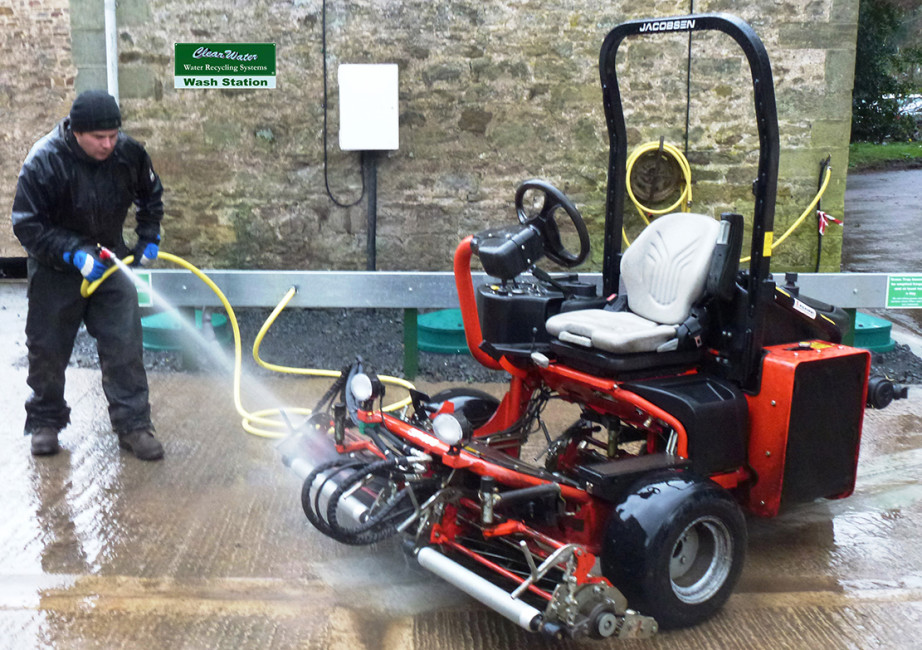
Wash and Clean: You can't carry out maintenance tasks, or inspect for wear and damage on dirty machines, so they need to be cleaned!
Wash them down and blow out the radiator and the oil coolers. This removes not only the grass and dirt deposits, but also any other "matter" which may be plastered around the machine.
Lubrication: With the machine washed and cleaned, its much safer and easier to get to all the greasing points and lubricate where required. The operator's instruction book will identify which fittings need either daily or weekly attention.
Inspection: As the washing, cleaning and lubrication is carried out, a visual inspection of the machine can be completed. Any bent, damaged or missing parts need to be identified and reported so the necessary repairs can be made.
Refuel: The fuel tanks should be filled at the end of the day, so there is less chance of condensation forming inside the tank as it cools down. While there are water separators in the fuel filtration systems, it's clearly better to prevent it getting into the tank in the first place.
The Defect Sheet: Where bent, worn or damaged parts are identified, they must be reported so replacement parts can be ordered, and workshop time allocated to make the necessary repairs. Any recurring faults or overheating issues should also be reported, so they can be investigated before more serious failures occur.
So, there are several checks and tests to be made to a machine before it starts, and several things to do after each working day. Operations must allow operators sufficient time to complete pre-start checks and meet the daily/weekly maintenance requirements. By following these simple steps, machinery will be more productive and, ultimately, more reliable.
